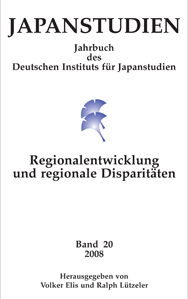
細部
2008, iudicium Verlag, München, 344 p. [オーダー]著者
ラルフ・リュツェラー
レビュー
japaninfo.at/news/buch_537-regionale-entwicklungen-und-ungleichheiten
Japanstudien 20
Regionalentwicklung und regionale Disparitäten (Regional Development and Regional Disparities)

For years, the discourse on Japan’s regional structure has been dominated by the hyper-concentration of economic, cultural, political and societal functions on the Tokyo metropolis and the corresponding relative insignificance of all other regions. Recently, however, new developments have become apparent which might lead to a more diversified regional structure. These developments are:
- political decentralization and the amalgamation of municipalities as an instrument to cut administrative expenditures. This might save some municipalities from bankruptcy, but could also lead to oversized administrations out of touch with their citizens;
- a paradigm change in regional planning: the State abandons its task of mitigating regional disparities and calls upon the direct responsibility of each commune and prefecture instead;
- a deepening gap between shrinking and growing regions. For overcrowded areas, though, the shrinking process might also offer new opportunities;
- the undocking of specific urban quarters in Tokyo or in the Kansai region from the rest of their city region as a result of efforts to compete with top locations of other world metropoles.
Overall, these developments might lead to an even stronger association between place and living conditions in Japan. Furthermore, not only rural regions, but a significant number of cities as well will have to cope with population losses, which is almost the opposite of the well-known problems linked to overcrowding that have been charcterizing large parts of urban Japan up to now. Japanstudien 20 intends to deal with these new trends from various perspectives and disciplines, including demographics, geography, sociology, political science, economics, jurisprudence and cultural studies.
コンテンツ
Landes- und Regionalentwicklung zwischen Wachstum und Schrumpfung: Regionale Disparitäten und räumliche Planung in Japan
pp. 35-67
Schrumpfende Städte als Herausforderung: Japan, Hokkaidō und der Fall der Stadt Yūbari
pp. 69-102
Weite Himmel über der Kaiserstadt: Die Kehrtwende in Kyotos Stadtplanung
pp. 103-128
Kommunale Gebietsreformen der Heisei-Zeit und lokale Identität: Das Beispiel der Kommune Arita-chō
pp. 163-192
Eine neue Identität für Regionalstädte: Deindustrialisierung, kommunale Gebietsreform und Tourismus
pp. 193-222
Japanese Rural Revitalization: The Reality and Potential of Cultural Commodities as Local Brands
pp. 223-245
Recent Developments in the Representation of National Memory and Local Identities: The Politics of Memory in Tsushima, Matsuyama, and Maizuru
pp. 247-277
The Local Dimension of Energy and Environmental Policy in Japan
pp. 281-305
From Environmental Accountability to Corporate Social Responsibility? Reflections on the CSR Boom in Japan from the Perspective of Business Management and Civil Society Groups
pp. 307-329
小島毅『靖国史観―幕末維新という深淵』筑摩書房 Kojima, Tsuyoshi: Yasukuni shikan. Bakumatsu ishin to iu shin’en [Das Yasukuni-Geschichtsbild. Aus den Tiefen der Bakumatsu-Restauration] (= Chikuma Shinsho; 652)
pp. 345-352
Köhn, Stephan und Martina Schönbein (Hg.): Facetten der japanischen Populär- und Medienkultur 2
pp. 364-368
Maltarich, Bill: Samurai and Supermen. National Socialist Views of Japan
pp. 369-376
島田裕己『日本の10大新宗教』幻冬舎 Shimada, Hiromi: Nihon no jūdai shin-shūkyō [Japan’s ten big new religions]
pp. 377-381
北岡伸一『国連の政治力学-日本はどこにいるのか』中央公論社 Kitaoka, Shin’ichi: Kokuren no seiji rikigaku – Nihon wa doko ni iru no ka [The political dynamics of the United Nations – Where does Japan stand?] (= Chūkō Shinsho; 1899)
pp. 382-387
Regionalentwicklung und Ungleichheit: Raumdisparitäten als Thema zur Prime time – eine Einführung
pp. 15–33
Ruheständler als Lebenselixier? Ruhestandswanderung und lokale Neubelebungsstrategien am Beispiel von Atami und Ishigaki
pp. 129-162